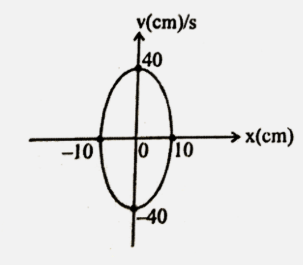A particle executing simple harmonic motion with time period T. the time period with which its kinetic energy oscillates is
T
2T
4T
T2
The correct Answer is:D
To solve the problem, we need to determine the time period of the kinetic energy of a particle executing simple harmonic motion (SHM) with a given time period T.
1. Understanding Simple Harmonic Motion (SHM):
- A particle in SHM oscillates between two extreme positions (maximum displacement) and passes through a mean position (equilibrium position).
- The time period T is the time taken to complete one full cycle of motion.
2. Velocity in SHM:
- The velocity of the particle is maximum at the mean position and zero at the extreme positions.
- The velocity v(t) can be expressed as a function of time, typically in the form v(t)=Aωcos(ωt+ϕ), where A is the amplitude, ω is the angular frequency, and ϕ is the phase constant.
3. Kinetic Energy in SHM:
- The kinetic energy KE of the particle is given by the formula:
KE=12mv2
- Substituting the expression for velocity, we get:
KE(t)=12m(Aωcos(ωt+ϕ))2=12mA2ω2cos2(ωt+ϕ)
4. Analyzing the Kinetic Energy Oscillation:
- The kinetic energy oscillates between 0 (when the velocity is 0 at the extreme positions) and a maximum value (when the velocity is maximum at the mean position).
- The kinetic energy reaches its maximum value when cos2(ωt+ϕ) is at its peak (which occurs every half cycle of the motion).
5. Determining the Time Period of Kinetic Energy:
- Since the kinetic energy reaches its maximum value twice during one complete cycle (once going towards the mean position and once coming back), the time period of the kinetic energy oscillation is half of the time period of the motion.
- Therefore, the time period of the kinetic energy oscillation is:
TKE=T2
Final Answer:
The time period with which the kinetic energy oscillates is T2.
---
- A particle in SHM oscillates between two extreme positions (maximum displacement) and passes through a mean position (equilibrium position).
- The time period T is the time taken to complete one full cycle of motion.
- The velocity of the particle is maximum at the mean position and zero at the extreme positions.
- The velocity v(t) can be expressed as a function of time, typically in the form v(t)=Aωcos(ωt+ϕ), where A is the amplitude, ω is the angular frequency, and ϕ is the phase constant.
- The kinetic energy KE of the particle is given by the formula:
KE=12mv2
- Substituting the expression for velocity, we get:
KE(t)=12m(Aωcos(ωt+ϕ))2=12mA2ω2cos2(ωt+ϕ)
- The kinetic energy oscillates between 0 (when the velocity is 0 at the extreme positions) and a maximum value (when the velocity is maximum at the mean position).
- The kinetic energy reaches its maximum value when cos2(ωt+ϕ) is at its peak (which occurs every half cycle of the motion).
- Since the kinetic energy reaches its maximum value twice during one complete cycle (once going towards the mean position and once coming back), the time period of the kinetic energy oscillation is half of the time period of the motion.
- Therefore, the time period of the kinetic energy oscillation is:
TKE=T2
The time period with which the kinetic energy oscillates is T2.
Topper's Solved these Questions
- BOOK - NCERT FINGERTPS ENGLISHCHAPTER - OSCILLATIONS EXERCISE - Higher Order Thinking Skills8videos
OSCILLATIONS
- BOOK - NCERT FINGERTPS ENGLISHCHAPTER - OSCILLATIONS EXERCISE - Exemplar Problems9videos
OSCILLATIONS
- BOOK - NCERT FINGERTPS ENGLISHCHAPTER - MOTION IN A STRAIGHT LINEEXERCISE - NCERT Exemplar6videos
MOTION IN A STRAIGHT LINE
- BOOK - NCERT FINGERTPS ENGLISHCHAPTER - PHYSICAL WORLDEXERCISE - Assertion And Reason10videos
PHYSICAL WORLD
Similar Questions
Knowledge Check
- Question 1 - Select One
If x, v and a denote the displacement, the velocity and the acceleration of a particle executing simple harmonic motion of time period T, then, which of the following does not change with time?
AaTvBaT+2πvCaTxDa2T+4π2v2 - Question 2 - Select One
A particle is executing simple harmonic motion. Its total energy is proportional to its
Adisplacement from equilibrium positionBfrequency of oscillationCsquare of amplitude of motionDvelocity at equilibrium position
A particle is executing simple harmonic motion with a time period T. At time t=0, it is at its position of equilibium. The kinetice energy -time graph of the particle will look like
View SolutionFor a particle executing simple harmonic motion, the acceleration is proportional to
View SolutionA particle executes a simple harmonic motion of time period T. Find the time taken by the particle to go directly from its mean position to half the amplitude.
View SolutionIf x, v and a denote the displacement, the velocity and the acceleration of a particle executing simple harmonic motion of time period T, then, which of the following does not change with time?
View SolutionThe plot of velocity (v) versus displacement (x) of a particle executing simple harmonic motion is shown in figure. The time period of oscillation of particle is :-
 View Solution
View SolutionA particle is executing simple harmonic motion with an amplitude A and time period T. The displacement of the particles after 2T period from its initial position is
View Solution

